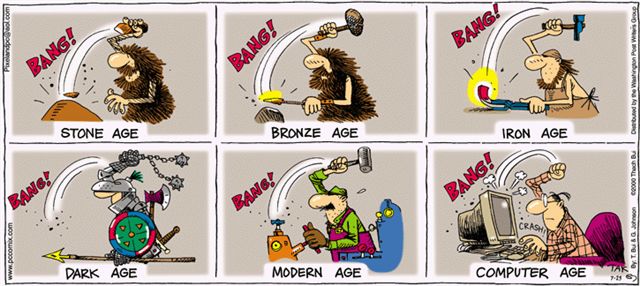How to thrive in the second machine age
— October 18, 2014As a teenager in India, back in the early 1990’s I was used to standing in long lines at my local bank to get a token ( a metal token embossed with the logo of the bank with a number indicating my turn). Once a clerk at the counter handed me a token I waited in the corridor of the bank for my number to be called. After half an hour or so, I could finally withdraw cash from the bank.
Most of us never questioned the loss of productive time and the inconvenience caused by this system, which was highly manual. As the years passed I saw a few computers in the bank and then one day my local bank installed an ATM machine.Customers were issued debit cards and could withdraw cash from this magic machine without waiting inline for a token.
Fast forward to 2014 and Banks in India are highly computerized, most transactions happen online, and customers routinely use ATM’s ( though there are daily limits on the amount that can be withdrawn). There are still long lines in banks, but there are fewer employees serving customers.
Some of my relatives work in the banking industry. One of them is a branch manager; he complains about long hours of work and limited staff, which is in contrast to the relaxed, high-paying banking jobs of the past. The double whammy of technology and privatization has disrupted the banking industry in India and the world.
The banking industry is just one of the industries hit by the disruptive force of technology. There are many other victims. Newspapers, music, television and manufacturing industries have also been disrupted by technology. If you are an individual or a business it’s important to understand the nature of a disruptive force before you can adapt to it.
Technology is an indispensable part of our lives today. However a century back none of the stuff that we take for granted today existed. There are two powerful forces behind the rise of technology (1) The advent of Capitalism (2) The abundance of Energy in some of the developed nations in the early part of this century.
Capitalism unleashes human potential through market forces and incentives. It might not perfect but it has raised the living standards of people in many countries. One of the primary incentives in a capitalistic system is “profit”, and profit is the difference between the price that customers are willing to pay for a product and the cost of producing that product. The same applies to services. So it’s natural for a capitalist to focus on reducing his cost of producing or rendering a service.
Apart from the cost of production a business has to pay attention to quality in order to maintain demand for its products or services. Human labor is critical to both the cost of producing a product and quality. The following drawbacks of human labor are powerful incentives for businesses to replace their workforce with technology.
- Human labor is expensive in some parts of the world
- Human labor can be inconsistent and unreliable
- Human labor can’t work 24 hours a day, and 7 days a week
- Human labor needs training and monitoring
- Human labor is prone to attrition
However, not all tasks can be automated. This is one of the key factors for understanding the disruptions caused by technology. In the book The Second Machine Age author Erik Brynjolfsson writes
MIT professors Daron Acemoglu and David Autor suggests that work can be divided into a two-by-two matrix: Cognitive versus manual and routine versus non-routine. They found that the demand for work has been falling most dramatically for routine tasks, regardless of weather they are cognitive or manual. This leads to job polarization: a collapse in demand for muffle-income hobs, while non routine cognitive jobs (such as financial analysis) and non-routine manual jobs ( like hair dressing) have held up relatively well.
Conclusion
Faced with the disruptive force of technology,it’s critical for everyone in the labor force to understand the risks and opportunities in a technology-driven world. The demand for any routine skills ( manual or cognitive ) will continue to decline. The jobless recoveries that have defined the recent recessions are a strong indication of this new reality.
The demand for many skills that can be replaced by a machines or software will decline over time. These skills can be both manual and cognitive. If you are a bank tellers, financial planners, machine operators your time is running out.
The good news is that it’s not all doom and gloom.
After the reigning world champion Garry Kasparov lost to the IBM computer Deep Blue in 1997, head-to-head contests between people and chess computers lost much of their allure;
Many came to the conclusion that humans no longer have anything to contribute to the game of chess. But the invention of “freestyle” chess tournaments shows how far this is from the truth. In these events, teams can include any combination of human and digital players.
As Kasparov himself explains – the teams of human plus machine dominated even the strongest computers. The chess machine Hydra which is a chess-specific computer like Deep Blue, was no match for a strong human player using a relatively weak laptop.
The key insight from the “freestyle” chess event is that people and computers don’t approach the same task the same way and there are areas where human + computer combinations are better than computers or human operating alone.
The secret to thriving in the second machine age is to find the sweet spot where a machine complements your skills rather than competing with you.


Leave a reply